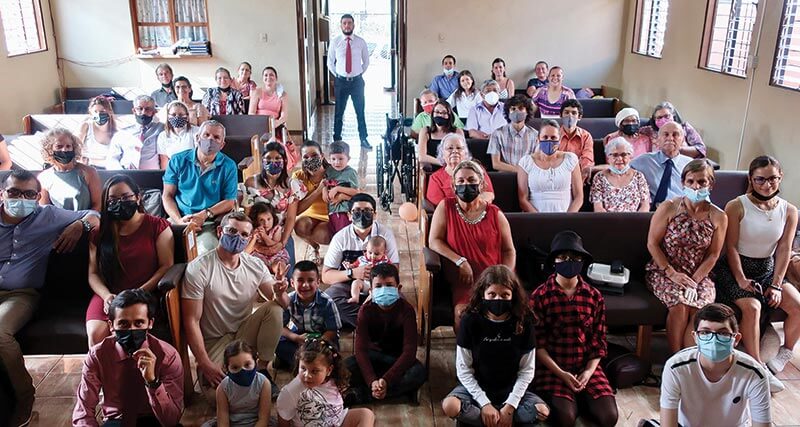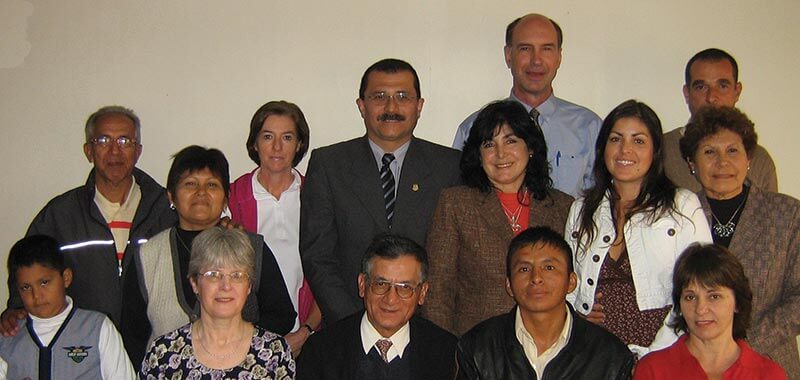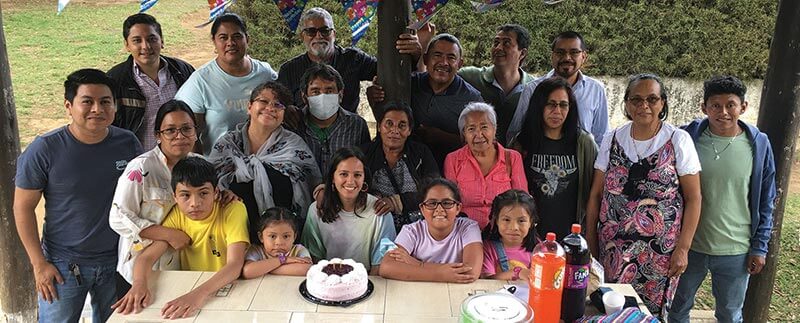The Truth in Latin America
The Truth has been growing in Mexico, Central, and South America since the late 1950s, when missionary families began residing in several countries. Currently, our mission workers support seventeen ecclesias in fifteen countries across Latin America.
 Read Time: 9 minutes
Read Time: 9 minutes
In previous issues, we briefly examined the growth of the Truth in Africa and the Philippines. Accepting the Truth in those regions has led to exponential growth in our community, and we are better because of it. In this issue, we will look southward to Latin America, where the story is quite different but represents an important opportunity for the Truth today. We are grateful to Bro. Dennis Paggi, Chairman of the CBMA, for his insights into the challenges and opportunities of Latin America.
Historical Background
Under the direction of the Papacy, the major powers of Europe launched the Crusades of the 11th-13th Centuries. They were, by most accounts, highly successful. They had seized control of parts of Turkey and Jerusalem from Islam. They created a chain of Crusader states and returned a massive bounty to Europe. But, by the late 1300s, Jerusalem had again come under the control of the Ottoman Turks, and much of the Church’s influence was lost in the region.
By the late 1400s, Spain landed in Santo Domingo (now the Dominican Republic) and initiated a seismic influence on the people of Latin America. The people of the region bore no resemblance to the sophisticated and combative Moors the Crusaders had met. Anthropologists estimate there was a marked social and economic disparity between the European invaders and the indigenous society. Some estimate the region had only reached the sophistication and cultural development of the first Egyptian dynasty (3,000 BC).
The Aztecs, Mayans, and the Inca lived in sedentary, agricultural communities, some of which were subject to more advanced cultural influences. But many others were nomadic and tended to be more primitive in culture and religion. Their religions incarnated traditional dualisms: day and night, sun and moon, good and evil, subject to an overarching, implacable fate.
The Spanish came not to explore and settle, but to exploit.
The amazing rapidity with which these cultures were destroyed resulted, at least in part, from the superiority of Spanish weaponry, the use of horses (which had disappeared in indigenous prehistory), and the annihilation of ancient beliefs and customs to impose a religion and form of life incomprehensible to the indigenous peoples.1
The Spanish came not to explore and settle, but to exploit. Latin America was filled with mined and unmined gold. They would send this valued bounty back to Europe. It’s estimated 90% of the gold in Europe’s Catholic churches came from Latin America. As intermarriage occurred between Spaniards and local indigenous peoples, the children (and generations afterwards) were classified as “mestizo,” which means “mixed blood.” These mixed people were considered well below the status of their pure-blooded Spaniard overseers. In the process, this robbed indigenous families of their culture and traditions.
The non-valuation of the indigenous culture and religion led eventually to a region which lost its identity. The explorers forced the Catholic religion, along with its hierarchy, organization, and authority on them. They were given new names and an imposed cultural structure to live within.2
To this day, the influence of Spain and Portugal is deeply felt in Latin America. From a religious point of view, Catholicism has remained dominant for over 500 years. But the impact is more profound than religion itself, for the Church serves as their “replacement” heritage and an inextricable part of their culture.
Christianity in Latin America Today
Latin America represents 50% of all Catholics worldwide. The area remains critically important to the Catholic Church. While Catholicism is still dominant in Latin America, it has been declining for more than one hundred years. This has been influenced by a number of factors, to include the shift of most economic ties from Europe to the United States. The increased influence of the United States has also precipitated the growth of Protestantism in the region.
Latin America represents 50% of all Catholics worldwide.
Dr. Gina A. Zuri wrote:
“Although the overall percentage of Christians changed little in Latin America over the 20th century, the internal composition of Christianity has changed significantly. Catholics remain the largest tradition, but Protestants (evangélicos) and Independents have been rapidly increasing their shares of Christianity in the continent. This includes Protestant denominations such as Presbyterians in Guatemala, Pentecostal groups such as the Assemblies of God in Brazil, and Independent Charismatic churches such as the Methodist Pentecostal Church and the Evangelical Pentecostal Church in Chile. Other Independent churches have also been growing rapidly, especially the Church of Jesus Christ of Latter-day Saints and Jehovah’s Witnesses in Brazil and Mexico.”3
Pentecostalism is now overwhelmingly anchored in Latin America rather than the United States. In Brazil, for example, the Assemblies of God has 10 million to 12 million members, while the American Assemblies of God Church has 2 million to 3 million. So now, the Brazilian church is the big brother that views the American church as mission territory.4
So, while Catholicism was relatively unchallenged and stable for centuries in the region, the past decades have introduced dramatic changes. This is the opportunity of Latin America for Christadelphians.
Christadelphia in Latin America Today
We commend for your reading a valuable documentary on the development of the Truth in Latin America. Bro. Stanley Owen’s book, “Into All the World”5 is a very edifying work and should be considered a welcome addition to any Christadelphian bookshelf. Pages 279-317 document the work of many brothers and sisters in Latin America, dating back to the days of Bro. Robert Roberts.
Today there are nearly 270 brothers and sisters spread across Latin America. These believers have emerged from the dominant grip of Catholicism to commit to reading the Bible for themselves and embrace sound doctrine. Many walked away from the “security” of the Catholic system, which could be a safety net in future times of difficulty. These are true disciples, willing to pursue the gospel regardless of cost.
Many of these brothers and sisters had been discouraged by membership in other churches because of their emphasis on soliciting money and the idea of easy salvation, as well as a lack of Bible study. Some have found the Truth while searching for a non-Trinitarian church. It is typical for family and friends of baptized members to be attracted through them, and those already-existing bonds strengthen the ecclesias.
The Truth has been growing in Mexico, Central, and South America since the late 1950s, when missionary families began residing in several countries. The Bible Mission’s commitment was to encourage and strengthen the lives of those in the new ecclesias with preaching, pastoral, and welfare assistance.
The largest ecclesias are located in Costa Rica, Ecuador, El Salvador, southern Mexico, and Panama. Much of the early growth came when resident missionary families lived in these countries, raising families and nurturing ecclesias.
Panama, Ecuador, and El Salvador have ecclesias established in the most populated cities. Costa Rica and El Salvador consistently had resident missionaries from 1970-1990. Ecuador began flourishing with several different resident missionaries during 2002-2013. Panama had a number of resident missionaries until 2009. Efforts in southern Mexico began about ten years ago and resulted in the establishment of two ecclesias and nearly forty baptisms.

Currently, our mission workers support seventeen ecclesias. Besides the 270 baptized members, there are an estimated 150 Sunday School and CYC members. Prior to the pandemic, ecclesias annually performed about twenty-five baptisms in Latin America. Since the pandemic, with the inability to travel to those countries, there has been a significant decrease in baptisms. However, during this time, new virtual forms of preaching have been developed.

Today, fifteen countries across Latin America have ecclesias. Most of the preaching was historically executed through newspaper advertising and local campaigns. The predominant language spoken locally is Spanish, with the exception of Portuguese in Brazil. Many of our brothers and sisters live in isolation, often hundreds or thousands of miles from other believers. Developments in technology have recently enabled them to connect to their brothers and sisters via Skype, WhatsApp, and, more recently, Zoom.

The unexpected benefit emerging from the pandemic has been the virtual connectivity across the region. It has also increased global connectivity, allowing members in many of these countries to connect for memorial services with ecclesias in the United States and other countries.
As is true in North America, Study Days and Bible Schools represent a very important opportunity for fellowship in Latin America. Most ecclesias hold one or more Study Weekends each year, sometimes tied to a holiday weekend in their particular country.
Both Costa Rica and El Salvador hold an annual Bible School weekend, roughly between Christmas and the New Year. This past year in El Salvador, with a group totaling 83, all classes were taught by Latin American brothers, and there were attendees from Chile, Bolivia, Argentina, Campeche Mexico, Honduras, and Guatemala.
Challenges
Latin America shares the everyday challenges of human nature. There has been some movement in the Western world away from Judeo-Christian thinking, especially any “fundamentalist” variety of it, of which our community is representative. There is increasing drift toward secularism, selfishness, towards mystical, eastern-style religious ideas and a turning away from what we would consider healthy spirituality. This tendency doesn’t affect the older population of Latin America but is beginning to become noticeable in the younger generation.
Though vaccinations are now readily available in many countries of Latin America, the after-effects of COVID-19 continue to be a challenge. A recent United Nations report by the Economic Committee for Latin America and the Caribbean (ECLAC) headlined the general experience of too many in Latin America. They wrote, “Extreme poverty in Latin America rises to 86 million in 2021 due to the deepening of the social and health crisis prompted by the COVID-19 pandemic.”6
Brothers and sisters, interested friends, and the population in general, though hard-working, are living through more difficult economic times in Latin America than we in the comfort of North America can imagine. Basic survival for them means long work hours and thus limited opportunities and energy for contemplation of spiritual matters.
The Great Opportunity Before Us in Latin America
COVID-19 forced us (throughout the world) to learn different ways to connect and communicate. During the past two years, Bro. Kevin Hunter has been active in modifying our correspondence course to become more interactive. We are learning techniques to target ads in areas of proven prior interest, and to focus on new locals in Latin America where it is felt there might be interest in God’s word. If you have training or expertise in internet marketing, or would like to join the postal course team, please contact us.
We hope, God willing, that missionaries will be needed in 2023 in areas like Lima, Perú, and Guatemala City, Guatemala, where small, somewhat struggling but viable ecclesias already exist. Sunday School teachers are needed in Jalisco Sur, Mexico. The Bible Mission provides Spanish language training during the first few months of missionary service. If you are interested in serving in Latin America, we anticipate there will be a place for you to serve in 2023.
Please contact us to start the conversation at contact@cbma.net.
Dave Jennings
1 Dussel, Enrique D., Historia de la iglesia en América Latina, 3d ed. (Barcelona, 1974), translated into English as History of the Church in Latin America (Grand Rapids, MI., 1982).
2 From a lecture given by Juan Carlos Valarezo, Professor of International Relations, Pontifical Catholic University of Ecuador, on June 9, 2022. Attended by Bro. Dennis Paggi
3 Zurl, Dr. Gina A., Christianity in Latin America, World Christian Encyclopedia, 3rd edition (Edinburgh University Press)
4 Esqueda, Octavio Javier, Growth and impact of Pentecostalism in Latin America, Christian Education Journal, Fall 2013.
5 Owen, Stanley, Into All the World, The Cromwell Press, Trowbridge, UK, 1998.
6 Annual Report Social Panorama of Latin America, ECLAC, Extreme Poverty in the Region Rises to 86 Million in 2021 due to the Deepening of the Social and Health Crisis Prompted by the COVID-19 Pandemic, January 2022.